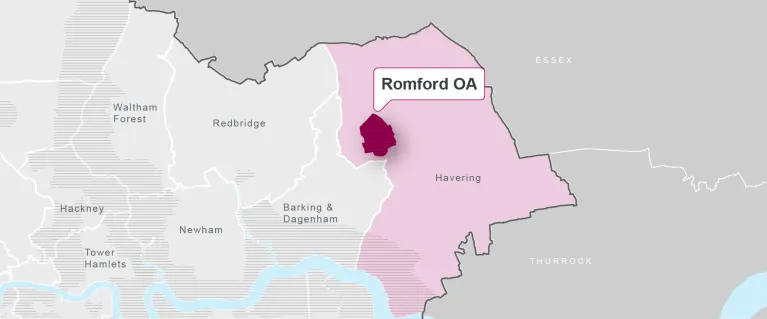
Romford Opportunity Area
Key information
Growth corridors make it easier to manage development in London as they group similar or nearby OAs
OA boundary and policy status will either be: 'Adopted', 'Emerging' or 'To be defined'
London planning documents are accurate at the tie on publication. These include key planning documents that directly relate to the OA. They must be read in the context of the relevant statutory planning policies contained within the borough’s Local Plan.
London Plan AMR Category (AMR, 2018) will either be: 'Nascent', 'Ready to grow', 'Underway', 'Maturing' or 'Mature'.
Overview of the OA
Romford is identified in the Mayor’s London Plan1 as an Opportunity Area (OA) with potential for 5,000 new homes and 500 new jobs by 20412. The OA was designated 2021 and is part of the Elizabeth Line East Growth Corridor. See Figure 1 and 2.
What is an Opportunity Area (OA)?
Opportunity Areas or OAs are London's key locations that have potential for large scale development, providing substantial new jobs and homes. OAs typically have capacity for at least 2,500 homes or 5,000 jobs, and many are linked to potential public transport improvements.
1 The London Plan is the statutory Spatial Development Strategy for London. As the overall strategic plan for London, it sets out an integrated economic, environmental, transport and social framework for the development of London over the next 20-25 years.
2 Figures based on London Plan evidence. Homes figures are based on 2017 Strategic Housing Land Availability Assessment (SHLAA, 2017) for the period 2019 – 2041. Jobs figures are based on London Employment Sites Database (LESD, 2017) for the period 2016 – 2041.
How many new homes have been delivered?
Since 20191, over 150 new homes were completed in Romford OA2. Since the OA was designated in 2021, over 190 new homes have been completed2. See Figure 3 and 4.
1The London Plan 2021 homes figures are based on the SHLAA (2017) evidence and capacity from 2019 to 2041. As such, 2019 is used as the starting point for measuring housing completions in the OA. Source: Strategic Housing Land Availability (SHLAA, 2017).
2 Source: London Datahub, Greater London Authority.
How many of these new homes are affordable?
Of the total new homes completed in Romford since its designation, approximately 4% of these new homes are considered affordable homes1. See Figure 7 and 8.
The National Planning Policy Framework (NPPF) provides a definition of affordable housing for planning purposes. Within this broad definition, sections 4.6.3 - 4.6.9 of the London Plan sets out the Mayor’s preferred affordable housing tenures and other genuinely affordable housing products.
1 Source: London Datahub, Greater London Authority.
Next steps to monitoring progress in the OA
The London Datahub is the GLA's main source of development data. The Datahub holds detailed information on planning applications, permissions, commencements and completions in Greater London enabling the tracking of development progress across London. The data received is supplied by applicants for planning permissions and may be subject to inherent issues and errors. For more information on how the data is collected please see the Planning London Datahub.
While delivering affordable homes and creating and protecting jobs are key components of the London Plan, the Mayor also recognises that future development in the city must be sustainable and inclusive.
The London Plan, therefore, sets out a new way of doing things, something that is called Good Growth. Good Growth is about working to delivery a more socially integrated and sustainable city, where people have more of a say, and growth brings the best out of existing places while providing opportunities to communities. Good Growth is not about supporting growth at any cost.
To understand the impact of the London Plan, the Mayor is legally required to keep the London Plan under review. Key Performance Indicators (KPIs)and the approach to monitoring the Plan is set out in its final chapter and provides the basis for an ongoing and iterative assessment of the effectiveness of the Plan. Performance against the KPIs is reported in the statutory Annual Monitoring Report (AMR) which is published by the Mayor each Spring.
In additon to monitoring the progress of homes, jobs and infrastructure, the AMR will also monitor a range of other data that relates to the Good Growth objectives and the Mayor's vison for London to be socially and economically inclusive and environmentally sustainable. These will be measured through a combination of KPIs listed in Table 12.1 of the London Plan 2021 and other performance measures which will be developed as part of the London Plan AMR.
Other revelant OAs
How can we improve this OA webpage?
This webpage is updated frequently. If there are any inaccuracies or if you would like to suggest improvements, please send your feedback to [email protected]
Need a document on this page in an accessible format?
If you use assistive technology (such as a screen reader) and need a version of a PDF or other document on this page in a more accessible format, please get in touch via our online form and tell us which format you need.
It will also help us if you tell us which assistive technology you use. We’ll consider your request and get back to you in 5 working days.